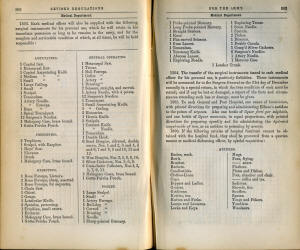1861 Army Supply Table
List of instruments for the field & hospital during the first year of the Civil War
This is the Union Army Medical Department's 1861 Revised Army Supply Table, which listed the surgical instruments recommended for a 'field' or 'hospital' unit. This table can be used to help date a given surgical set based on what was specified to be contained in a given type of set during the early days of the Civil War. The composition of the set specifications changed later in the War as needs, a new Surgeon-General, and the Army Medical Department organization changed.
Click on the images to enlarge
Note carefully article 1304 on the upper right, which states without doubt that "the transfer of the surgical instruments issued to each medical officer for is positively forbidden. These instruments will be accounted for the Surgeon-General on the 31st day of December annually in a special return in which the true condition of each must be stated; and if any be lost or damaged, a report of the facts and circumstances attending each loss or damage, must be given."I would think this provides all the documentation necessary to confirm the fact that surgeon's were expected to return their instruments when leaving the Army, and the instruments supplied by the Army would not have been engraved with the surgeon's name or regiment as is seen on some sets obtained post-War. These regulations obviously do not apply to state volunteer militia surgeons, whose sets or instruments may have in fact been brought to the War and used by their unit medical staff.Another excellent resource, with lists of instruments to determine the composition of early Civil War sets, especially those used before the Union Army made detail lists of instruments for the Hospital Department Purveyors use, can be found in Hamilton's book on Military Surgery, published in 1861.A Practical Treatise on Military Surgery by Frank Hastings Hamilton, MD, 1861
Instrument lists after the first year of the War
The following is the later set of specifications as published in the Regulations of the Medical Department by Grace and in the Medical and Surgical History, note changes and greater details.Source: "The Medical and Surgical History of the War of the Rebellion. (1861-65.) Part III, Volume II, Chapter XIV.--The Medical Staff and Materia Chirugica"(1) The Capital Operating Case contained: 2 amputating knives (one long, one medium), 2 catlings (one long, one medium), 4 scalpels, 1 cartilage knife, 1 capital saw (long, bow, two blades), 1 metacarpal saw, 1 chain saw, 1 Hey's saw, 1 trephine (conical), 1 trephine (small crown), 1 bone forceps (Liston's long, sharp, spring handle), 1 bone forceps (broad edged, slightly carved, spring handle), 1 bone forceps (gnawing, spring handle), 1 bone forceps (sequestrum, spring handle), 1 artery forceps, 1 artery needle, 1 artery needle key, 12 surgeon's needles, 1 tourniquet screw with pad, 1 tenaculum, 1 scissors, 1 chisel, 1 gouge, 1 mallet, 4 drills (with one handle), 2 retractors, 1 raspatory, 1 elevator, 1 brush, 12 yards suture wire (iron), ¼ oz. ligature silk. 1/8 oz. wax, 1 mahogany case (brass bound, slide catch), 1 leather pouch.
(2) The Minor Operating Case contained: 1 amputating knife, 3 scalpels, 2 bistouries, 1 hernia knife, 1 finger knife, 1 artery forceps, 1 ball forceps, 1 gullet forceps, 1 dressing forceps, 1 dissection forceps, 1 artery needle, 1 artery needle key, 12 surgeon's needles, 1 tenaculum, 2 scissors, 1 trocar and canula. 1 Belloc's canula, 1 bullet probe, 1 director, 1 cutting pliers (small), 6 steel bougies (silvered, double curve, Nos. 1 and 2, 3 and 4, 5 and 6, 7 and 8, 9 and 10, 11 and 12), 3 silver catheters (Nos. 3, 6, and 9), 6 gum-elastic catheters (Nos. 1, 3, 5, 7, 9, and 11), 24 suture pins (silvered), 6 yards suture wire (iron), ¼ oz. ligature silk, 1/8 oz. wax, 1 mahogany case (brass bound, slide catch), 1 leather pouch.
(3) The Pocket Case contained: 1 scalpel, 3 bistouries, 1 tenotome, 1 gum lancet, 2 thumb lancets, 1 razor (small), 1 artery forceps, 1 dressing forceps, 1 artery needle, 6 surgeon's needles, 1 exploring needle, 1 tenaculum, 1 scissors, 1 director, 3 probes, 1 caustic holder, 1 silver catheter (compound), 6 yards suture wire (iron), ¼ oz. ligature silk, 1/8 oz. wax, 1 Russia leather case.
(4) The Field Case contained: 2 amputating knives (one long, one medium), 2 catlings (one long, one medium), 3 scalpels, 2 bistouries, 1 hernia knife, 1 finger knife, 1 capital saw (long, bow, two blades), 1 metacarpal saw, 1 Hey's saw, 1 trephine (conical), I bone forceps (broad edged, slightly curved, spring handle), 1 bone forceps (sequestrum, spring handle), 1 artery forceps, 1 ball forceps, 1 dressing forceps, 1 dissection forceps, 1 artery needle, 1 artery needle key, 12 surgeon's needles, I tourniquet screw with pad, 1 tenaculum, 2 scissors, 2 retractors, 1 trocar and canula, 1 raspatory, 1 elevator, 1 brush, 1 bullet probe, 1 director, 6 steel bougies, silvered, double curve (Nos. 1 and 2, 3 and 4, 5 and 6, 7 and 8, 9 and 10, 11 and 12), 3 silver catheters (Nos. 3, 6, and 9), 6 gum-elastic catheters (Nos. 1, 3, 5, 7, 9, 11), 12 yards suture wire (iron), ¼ oz. ligature silk, ½ oz. wax, 1 mahogany case (brass bound, slide catch), 1 leather pinch; pocket case the same as allowed to staff surgeons.(5) The Pocket Case contained: 1 scalpel, 3 bistouries, 1 tenotome, 1 gum lancet, 2 thumb lancets, 1 razor (small), 1 artery forceps, 1 dressing forceps, 1 artery needle, 6 surgeon's needles, 1 exploring needle, 1 tenaculum, 1 scissors, 1 director, 3 probes, 1 caustic holder, 1 silver catheter (compound), 6 yards suture wire (iron), ¼ oz. ligature silk, 1/8 oz. wax, 1 Russia leather case.








